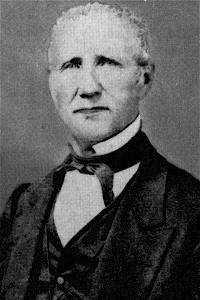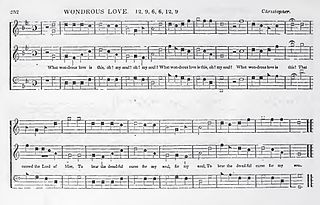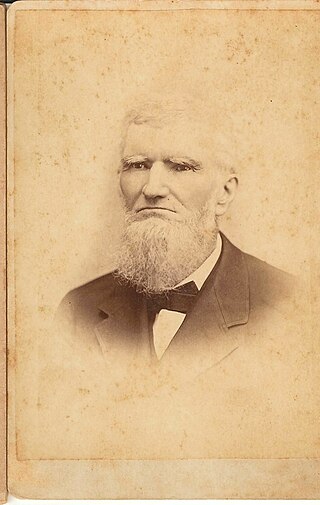Related Research Articles

Shape notes are a musical notation designed to facilitate congregational and social singing. The notation, introduced in late 18th century England, became a popular teaching device in American singing schools. Shapes were added to the noteheads in written music to help singers find pitches within major and minor scales without the use of more complex information found in key signatures on the staff.

Sacred Harp singing is a tradition of sacred choral music that originated in New England and was later perpetuated and carried on in the American South. The name is derived from The Sacred Harp, a ubiquitous and historically important tunebook printed in shape notes. The work was first published in 1844 and has reappeared in multiple editions ever since. Sacred Harp music represents one branch of an older tradition of American music that developed over the period 1770 to 1820 from roots in New England, with a significant, related development under the influence of "revival" services around the 1840s. This music was included in, and became profoundly associated with, books using the shape note style of notation popular in America in the 18th and early 19th centuries.
A singing school is a school in which students are taught to sightread vocal music. Singing schools are a long-standing cultural institution in the Southern United States. While some singing schools are offered for credit, most are informal programs.

The Southern Harmony, and Musical Companion is a shape note hymn and tune book compiled by William Walker, first published in 1835. The book is notable for having originated or popularized several hymn tunes found in modern hymnals and shape note collections like The Sacred Harp.

William Walker was an American Baptist song leader, shape note "singing master", and compiler of four shape note tunebooks, most notable of which are the influential The Southern Harmony and The Christian Harmony, which has been in continuous use.

Benjamin Franklin White was a shape note "singing master", and compiler of the shape note tunebook known as The Sacred Harp. He was born near Cross Keys in Union County, South Carolina, the twelfth child of Robert and Mildred White.
Wilson Marion Cooper of Dothan, Alabama, was a notable musician and music teacher within the Sacred Harp tradition. Marion Cooper was born in Henry County, Alabama, the son of W. S. and Elizabeth Ann (Oates) Cooper. He was a cousin of Alabama governor William C. Oates.
James Landrum White was a shape note singing teacher, composer, and a reviser of his father's shape note tunebook known as The Sacred Harp.
Joseph Stephen James, of Douglasville, Georgia, was a lawyer, community leader, shape note singer, composer, and a reviser of the tunebook known as The Sacred Harp.
The New Sacred Harp was a seven-shape note tune book released in 1884 through S.P. Richard & Son of Atlanta, Georgia.
David Patillo White (1828–1903) was a shape note singing teacher, composer, and a co-issuer, with his father, of the 1870 Sacred Harp. He was the second child of Benjamin Franklin White and Thurza Melvina Golightly, whose other children were William Decatur, Robert H., Mary Caroline, Nancy Ogburn, Thurza Melvina, Benjamin Franklin, Jr., James Landrum, and Martha America.
The Chattahoochee Musical Convention is a Sacred Harp singing convention. It is an annual gathering whose purposes are worshiping our Lord through the singing of Sacred Harp music and fostering of bonds of fellowship among singers. It bears the distinction of being the oldest surviving Sacred Harp musical convention, having been founded in 1852.
The Christian Harmony is a shape note hymn and tune book compiled by William Walker. The book was released in 1866. It is part of the larger tradition of shape note singing.

Ananias Davisson was a singing school teacher, printer and compiler of shape note tunebooks. He is best known for his 1816 compilation Kentucky Harmony, which is the first Southern shape-note tunebook. According to musicologist George Pullen Jackson, Davisson's compilations are "pioneer repositories of a sort of song that the rural South really liked."
The Union Harmony is a shape note hymn and tune book compiled by William Caldwell. The book was released in 1837, and is part of the larger tradition of shape note singing.
Elisha James King (1821-1844) was, with B. F. White, the compiler of The Sacred Harp, a shape note hymnbook that came to be used widely in the rural South. In revised form, the book continues to be popular among singers to this day.

"What Wondrous Love Is This" is a Christian folk hymn from the American South. Its text was first published in 1811, during the Second Great Awakening, and its melody derived from a popular English ballad. Today it is a widely known hymn included in hymnals of many Christian denominations.

Alfred Marcus Cagle was an American hymnwriter known for his activities with the Sacred Harp movement.

Edmund Dumas was an American Primitive Baptist minister, politician, and musician today remembered for his association with the Sacred Harp movement.
References
- The Sacred Harp: A Tradition and Its Music, by Buell E. Cobb, ISBN 0-8203-0426-3